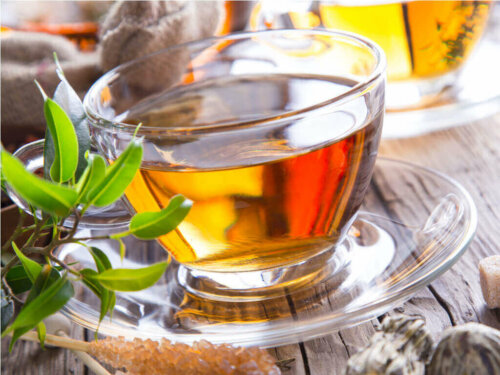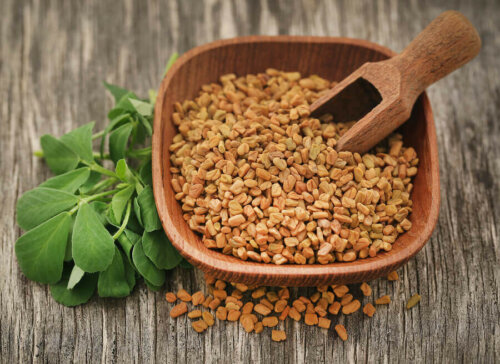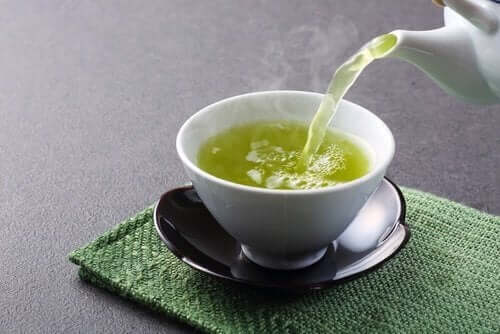4 Infusions to Lower Blood Sugar


Written and verified by the doctor Karla Henríquez
One of the simplest and healthiest ways to increase fluid intake to help lower blood sugar is to prepare drinks from natural ingredients.
For many people, it is not easy to increase their water intake because they do not find the “taste” of it. Fortunately, to solve this situation, it isn’t necessary to force things overnight. Instead, you can resort to certain tricks, such as interspersing water intake with natural juices and herbal teas.
For the most part, herbal teas have a mild flavor that is very convenient when it comes to “training” to increase our fluid intake. Here are some of the best options for lowering blood sugar.
Making an infusion
To prepare an infusion properly, a certain amount of water must be heated until it reaches boiling point. Now, once the boiling bubbles go down, add the infusion bag, tea or the root, leaves or flowers of the selected plant.
Then, so that the cooking is done properly, it’s important to cover the container for a few minutes. It should also be left to stand for at least five to eight minutes.
In this regard, it should be noted that there are infusions that should be left to stand for up to 12 minutes. So if you have opted for a commercial format, it is necessary to respect the resting time indicated on the packaging.

In general, these are the guidelines you should take into account to make a proper infusion.
Ingredients
- 1 c. of water
- 1 tbsp. of leaves, flowers, or root of any dry herb of your choice (10 g.) or two (20 g.) if you’re using fresh herbs.
Utensils
- A pot
- A cup
Procedure
- Incorporate the herbs and hot water in the teapot
- Allow it to steep for seven minutes
- Pour it into a cup when the time’s up
You can sweeten it with honey. However, the goal of these teas is to reduce your blood sugar levels so try to drink them as they are.
See also Improve Your Health with this Baking Soda Honey Mixture
Can you balance blood sugar levels?
The excess of glucose in your blood, or glycemia, is harmful to your health. You need to have energy throughout your day, there’s no doubt about that. But, exceeding the limits can steer you towards prediabetes. If you fail to control it well, it can eventually lead to diabetes, among other conditions.
Be aware that a person can have prediabetes and not show any symptoms. Furthermore, those with diabetes need to be especially careful with their diet. They also need to monitor their glucose levels constantly.
It’s a good idea to talk with a specialist before adding the teas that we’re going to talk about today to your diet.
1. Fenugreek

Due to its coumarins, nicotinic acid, and trigonelline content, fenugreek is often used as a substitute for oral hypoglycemics in cases of non-insulin dependent diabetes.
Several studies reveal that fenugreek not only reduces the absorption of glucides but also improves the peripheral action of insulin.
According to a study entitled: El efecto del fenogreco en la glucosa sanguínea, los parámetros de los lípidos, la insulina y la resistencia en las mujeres obesas con diabetes de tipo 2 (The effect of fenugreek on blood glucose, lipid parameters, insulin and resistance in obese women with type 2 diabetes), the consumption of fenugreek helps improve glucose and lipid parameters in obese diabetic patients.
2. Ginseng can balance blood sugar levels
Ginseng is a term used to identify several species of the Panax family. It grows wild in mountain areas from Nepal to Manchuria as well as in western Siberia and Korea. Because of the high demand for the plant, people in other countries grow it these days too.
Its glucose-lowering (hypoglycemic) action is due to its panaxoside content, which helps this function.
People with type 2 diabetes consumed 1 gram of American ginseng 40 minutes before their main meals, for 2 months, maintaining their usual treatment in a study.
Their blood glucose levels, on an empty stomach, dropped by about ten percent after this time. This effect seems to be due to its ability to increase insulin secretion in the body and improve cell response.
Also read A Ginger Garlic and Honey Remedy for High Cholesterol
3. Chamomile
This is a grassy annual plant that’s known for its antispasmodic and digestive properties. In addition to its ability to balance blood sugar levels, chamomile promotes the storage of glycogen in the liver. Additionally, it protects your pancreas from oxidative stress caused by an excess of glucose.
4. Green tea
Green tea comes from the plant Camellia Sinensis, which is originally from China. It’s become more popular in recent times, though, and its consumption has spread all over the planet. It has antioxidant properties as a result of its catechins as well its beta-carotene and C and E vitamin content.
It can effectively lower your blood sugar level. This ability is a result of the polysaccharides that are in its leaves as these positive impact blood sugar levels.

Other things to keep in mind about infusions to balance blood sugar levels
You must consult a doctor before starting any natural treatment. In addition, you must take into account that in order for phytotherapeutic treatments to be useful you must use them properly — hence the importance of consulting a professional.
High blood glucose levels can lead to various types of damage in the body. It’s for this reason that you must adhere to your physician’s established certain guidelines once they make a diagnosis.
Additionally, take into account that the above-mentioned infusions are a complementary aid, not a treatment in themselves. Thus, add them to a balanced diet and never use them as a substitute for food or medication.
All cited sources were thoroughly reviewed by our team to ensure their quality, reliability, currency, and validity. The bibliography of this article was considered reliable and of academic or scientific accuracy.
- Foldes, E. (1947). Diabetes and hypertension. The American Journal of Medicine. https://doi.org/10.1080/13854040802368684
- Diabetes.co.uk. (2017). Blood Sugar Level Ranges. https://doi.org/10.1016/j.bbadis.2016.09.015
- Cabrera, C., Artacho, R., & Giménez, R. (2006). Beneficial Effects of Green Tea—A Review. Journal of the American College of Nutrition. https://doi.org/10.1080/07315724.2006.10719518
- Tsuneki, Hiroshi & Ishizuka, Mitsuyo & Terasawa, Miki & wu, Jinbin & Sasaoka, Toshiyasu & Kimura, Ikuko. (2004). Effect of Green tea on blood glucose levels and serum proteomic patterns in diabetic (db/db) mice and on glucose metabolism in healthy humans. BMC pharmacology. 4. 18. 10.1186/1471-2210-4-18.
This text is provided for informational purposes only and does not replace consultation with a professional. If in doubt, consult your specialist.








